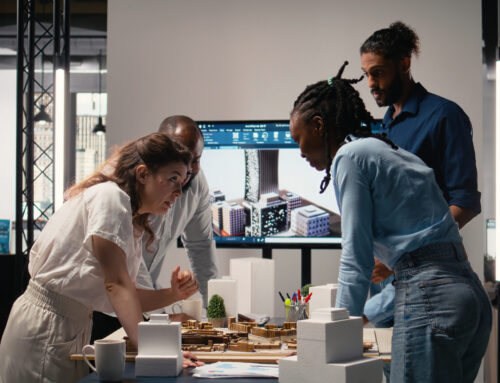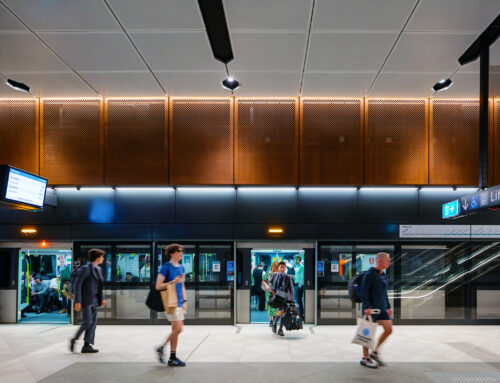While we face global water scarcity and endangered ecosystems, plumbing doesn’t tend to be talked about as urgently or passionately in the built environment as topics like electrification or artificial intelligence. However, well-designed plumbing can bring a business immediate cost savings, contribute towards sustainability accreditations, improve the surrounding ecosystem and address water scarcity.
Some of the earliest records of plumbing date back to 4000 BC, highlighting the importance of carefully managing our natural resources to look after the environment and life within it.
A heads up – this article uses ‘plumbing’ to describe hydraulics and public health engineering.
Plumbing is the lifeblood of a building
Humans can’t survive without water and safe wastewater disposal. Similarly, buildings can’t be built or operate without well managed water. It follows that the importance of water infrastructure, sanitation and public health is paramount in building design.
Construction
Construction sites rely on water for workers as well as the manufacturing of concrete and construction materials.
- Water infrastructure provides safe drinking water and sanitary drainage systems. It also ensures basic hygiene conditions are provided to site construction works, safeguarding health and wellbeing.
- As a vital resource the importance of focusing on re -use of water in construction materials, testing and commissioning phases of a project requires careful consideration.
Clean drinking water and sanitation
Access to clean drinking water enables life, improves lives and reduces health risks. These are the key considerations when designing for public health:
- Safe wastewater disposal and treatment ensures our oceans, rivers and streams are protected and decreases the risk of infectious diseases.
- Cold and hot water for washing hands, showering and cleaning to improve sanitation and health.
- Safe wastewater disposal and clean drinking water ensures the health and wellbeing of human life.
- The importance of selecting the right materials in your plumbing systems and ensuring the demand of lead-free plumbing products are used in all hydraulic systems.
Building operations
A building can’t open its doors without water.
- Water keeps a building warm and cool – it’s an essential requirement for heating and air conditioning. Water is cooled, or heated, and piped through mechanical systems to feed the infrastructure that helps to maintain a healthy building temperature.
- Water prevents building damage and keeps occupants safe by protecting facilities that have water supplied to them. This includes fire protection systems which carry mains water throughout a building to extinguish fires in the event of an emergency.
- Green spaces wouldn’t be green without water. It keeps vegetation alive, improves humidity, filters air and enhances the environment.
- Harvested rainwater can be used for all these systems as well as for flushing toilets.
Common plumbing problems
The cost of poor plumbing can be catastrophic. The most cost-effective way to avoid expensive mistakes is well-planned design.
These are the most common plumbing issues we’ve come across in the built environment.
Oversized pipework
It’s easier to oversize a system than accurately design a system. Excessive pipework can increase capital and operational expenditures and can have a negative impact on building system performance. Unfortunately, buildings are still being designed with systems that cater for greater-than-needed capacity due to outdated design standards.
Water conservation
Buildings that don’t use recycled water compound local, and global, water insecurity. They also neglect the protection and maintenance of sensitive water bodies.
Easy maintenance
Plumbing needs to cater for serviceability, maintenance and future flexibility. A poorly designed system can lead to an increase in operational expenditures, building resilience and greatly reduce the design.
Let’s take the example of stormwater and sanitary drainage systems. If these systems are installed with incorrect falls it can lead to critical and costly maintenance works to ensure the system operates without blocking up.
In the event of a sanitary system blocking up, human waste can ingress into a building causing costly sanitation cleans to allow building occupiers to return to using the building and not risk becoming unwell.
Insufficient monitoring
There is a common misconception that a typical building management system (BMS) can provide sufficient information for hydraulic services. This isn’t true. Most BMS provide little information for data collection of plumbing services.
Insufficient monitoring can lead to water leaks that are forgotten about, increased energy costs and poor system performance.
Changing the conversation about plumbing
We believe getting more people talking about plumbing will help us improve the industry and make changes that benefit us all. The best way to do this is by making a measurable impact on the projects we take on
Solve everyday problems for the people who matter
A good understanding of a building’s occupants – including tenants, visitors and operations teams – ensures systems are designed to work for the people who will use them.
Save money through more efficient systems
Hydraulics engineering needs to consider the building’s needs, both now and into the future, and challenge a design if it over-specifies pipework, volume, pressure and capacity. This saves money and increases efficiency, so the systems wear less and are easier to maintain and service.
Data collection and remote monitoring has grown in recent years. Remote monitoring can provide sufficient data collection to accurately design buildings as a true representation of how they will be used and assist with troubleshooting and maintenance.
Secure sustainability accreditation
Water conservation has emerged as a cornerstone of many sustainability certifications. These certifications recognise the significance of responsible water management and encourage building projects to implement water-efficient technologies, minimise water consumption and safeguard local water resources.
Green Star
This certification assesses building sustainability across multiple categories including water conservation. It focuses on water efficiency, responsible water use and innovative water management strategies. Achieving all water related initiatives accounts for over 25 per cent of a Green Star Buildings 5 Star rating.
Projects pursuing Green Star ratings often incorporate rainwater harvesting, low-flow fixtures and sustainable landscaping to reduce their impact on local water resources.
LEED (Leadership in Energy and Environmental Design)
This focuses on energy efficiency, environmental sustainability and occupant wellbeing. It encourages the implementation of water-saving fixtures, rainwater harvesting systems and water-efficient landscaping practices.
Projects are evaluated based on water use reduction, wastewater management, and innovative strategies to mitigate the building’s impact on local water resources.
BREEAM (Building Research Establishment Environmental Assessment Method)
This methodology evaluates the environmental performance of buildings. Water management is emphasised through strategies such as rainwater harvesting, greywater and soil waste recycling and minimising water consumption. The certification evaluates water usage, efficiency and overall impact on local water resources.
LBC (Living Building Challenge)
Known for its stringent criteria, this certification envisions buildings that operate as self-sufficient ecosystems. Water is a central component, and all projects must aim to achieve net-positive water usage. This involves treating and reusing water on-site, promoting local hydrology and eliminating wastewater discharge.
The certification pushes boundaries by encouraging buildings to give back to the environment through strategies like rainwater collection and innovative wastewater treatment systems.
NABERS (National Australian Built Environment Rating System)
Water conservation through responsible water consumption and management are crucial for a NABERS Water certification. Projects are evaluated based on water efficiency, leakage reduction and the integration of water-saving technologies.
THE GAME CHANGERS IN PLUMBING INFRASTRUCTURE
Innovation may appear to have taken a back seat in comparison with rapid advancements in energy innovation. While these technologies have often been more accessible to consumers – leading to increased adoption – there are many innovations in development which reflect the built environment’s drive to reach water neutrality and net zero.
Innovations rapidly becoming the norm
- Predictive maintenance through remote monitoring
- Water saving and reuse, for example WELS-rated fixtures, rainwater harvesting and reusing the water from fire sprinkler tests.
- Wastewater heat recovery and sewer mining
- Stormwater attenuation
- Geothermal energy
- Heating powered by renewable gas
- Air sourced heat pumps and water-cooled heat pumps
Experienced consultants can advise on effective and sustainable solutions for your project. They know systems and solutions and the importance of shaping each solution to fit the project at hand.
The future of plumbing
While preventing flooding or increasing the efficiency of pipework isn’t, yet, discussed to the same level as designing for a fossil fuel-free future and reducing whole-of-life carbon, the dial is shifting. Creativity and innovation in plumbing and water infrastructure aims to address water scarcity and ensure a sustainable supply of clean and safe water for future generations.
Let’s talk with plumbers, building maintenance staff, hydraulic consultants and engineers to develop better ways of doing things. Plumbing, hydraulics and public health need to be taken seriously and move further up our priorities. This is the only way we’re going to design robust plumbing infrastructure that can sustain clean water for future generations.










